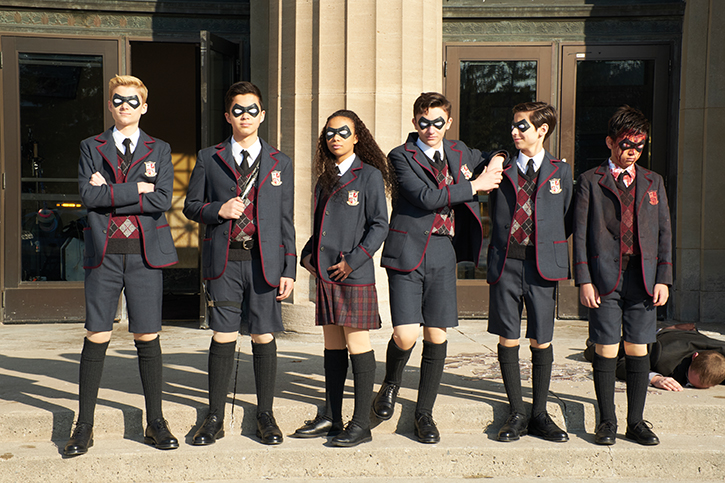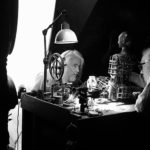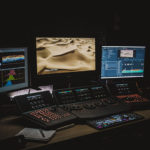
School for Scandal
The Umbrella Academy fits the genre that Netflix is most known for, the near future or parallel sci-fi narrative.
Words: Nicki Mills / Pictures: Netflix
On Definition we have followed the career of DOP Neville Kidd from his turn on BBC’s Sherlock to his Netflix work on Travelers and Altered Carbon. Now he has shared cinematography duties on The Umbrella Academy – Fargo’s Craig Wrobleski was the other DOP – currently streaming on Netflix. When we caught up with Neville he was busy shooting Steven Spielberg’s Amazing Stories in Atlanta for the new Apple streaming service that is rumoured to be arriving later this year.
Academy News
Steve Blackman acted as Executive Producer and writer on The Umbrella Academy and was also the show runner; continuing the Fargo connection, Steve also worked on Altered Carbon and Fargo. The new series is based on the popular, Eisner award-winning comics and graphic novels of the same name created and written by Gerard Way (My Chemical Romance), illustrated by Gabriel Bá, and published by Dark Horse Comics. The live-action series follows the estranged members of a dysfunctional family of superheroes, The Umbrella Academy – Luther, Diego, Allison, Vanya, Klaus and Number Five – as they work together to solve their father Reginald Hargreeves’ mysterious death, while coming apart at the seams due to their divergent personalities and abilities.
The show was made in the huge Kipling Avenue studio, which is part of Cinespace Studios in Toronto, where shows like Handmaid’s Tale and Titans were shot. Kipling is another post-industrial conversion, this time from an old glass factory, one of many studios in Toronto to house the huge explosion of production in the city.

Black Humour
If you have watched Fargo you’ll know that black humour wrapped up the violence, almost sanitising it, but not quite; Steve Blackman was a writer on Fargo and brings that same humour to this new show. Neville sets the scene: “Gerard Way from My Chemical Romance wrote the novel about 20 years ago and it became a cult classic in the US. Steve explained to me that they wanted to keep it very ‘Wes Anderson’ but in my head it’s more like Wes Anderson meets Battle Royale but with the Fargo dark humour.
“Visually we wanted to give it that Wes Anderson spin because of the dysfunctional family angle. But we wanted to adjust that and give it our own aesthetics. It’s a VFX-heavy show with one of the main characters, called Pogo, being a CG chimp. Weta Digital was brought in to produce the chimp and it was great to work with them to get the realism of Pogo (see our Pogo panel on page 46 to find out more about the character building). It was amazing to see Pogo come alive when Weta showed us the first demo.
“Weta took our lighting cues and then replicated them in post; if there was any confusion they would come back to us and ask what were we thinking at any particular scene, for instance if we wanted more light in the eyes at that point or wanted to take light away from the eyes. Any time there was any doubts you would just speak to them about it.”
In planning, the Weta team described what requirements they needed from the DOPs Neville and Craig; for instance the witness cameras had to be in 4K to capture a high enough resolution. “We started on Sony F5 cameras to be run either side, giving us full-length actor shots so they could apply that to the chimp character they were making.”
This was the first Netflix show that Weta had worked on. They brought their experience of working on Planet of the Apes to the character. To get this level of movie VFX expertise on Netflix shows how attractive the streaming services have become to predominately movie-only VFX houses.

“The show was made in the huge Kipling Avenue studio, which is part of Cinespace Film Studios in Toronto.”
 The Umbrella Academy uses techniques of black humour mixed in with violence.
The Umbrella Academy uses techniques of black humour mixed in with violence.
Altered Carbon – Same Again
Fresh from shooting the Netflix show Altered Carbon, Neville wanted to use the same cameras-and-lens combination. This meant that all his experimentation with the Arri Alexa 65 on that show would help with this one. “We wanted to have that same look and luckily Arri was happy to do a deal with the Alexa 65 for us to use that camera again. The great thing was that we started off using the Alexa Mini as our C camera and then the LF camera came out, so for the last half of the show we were filming with two Alexa 65s and an LF.
“I think we were the first show to combine the 65s and the new LF. Arri came out and looked at what we were doing with the two cameras so it was great working in collaboration with them for what helps us with the LF; the LF is a fantastic camera as well as the 65.
“It has a slightly smaller sensor than the 65 but it punches above its weight. Wefound it was a great match between the two cameras. I love the 65 because it has a distinct look, and for a C camera the Mini worked well but I knew it was a Mini. When you bring in the LF it’s hardly noticeable against the 65. I don’t think the average viewer will notice the difference, it’s marginal.
“I do love the 65, the size of that sensor is stunning and we were able to use the same lenses as we did with Altered Carbon. These were the Canon Cine Primes and the Cooke S5s which again was a great combination. Now fortunately there are more options lens-wise for the Alexa 65, lenses like the Zeiss Supremes which when we started shooting we couldn’t get hold of. Also you’ve got the Cooke S7s so we’re getting spoilt for choice now.
“I think going forward to Season 2, which we start in April, we might use the Zeiss Supremes for that – I’m using them now for the Amazing Stories shoot. I do love them. They also match very well with the Cookes. At the moment we’re up to 85mm on the Supremes and shooting a Cooke S5 100mm and S4 at 135mm, 150mm and 180mm. They’re a fantastic blend with the Supremes which are so fast as well.”

“Now fortunately there are more lens options for the Alexa 65, like the Zeiss Supremes.”

0
The number of times Weta Digital has made a character for Netflix before
750,000
The amount of square footage that Kipling Avenue Studio offers productions

Lighting the Academy
Neville wanted to adopt a different approach to the lighting for the new show. “I wanted to make the sets feel real, so we made a decision early on to have minimal lighting on the set by keeping it on the outside. It was a fantastic challenge to make the sets essentially 360˚ and to put minimal lights in and just try to use as much of the light coming in through the all windows to make it feel as real as possible, so it actually felt like a real house.
“So the actors can kind of go anywhere within reason and it felt like a real place and helped everyone relax within the world of The Academy. We didn’t want this world to be overly lit, although it made it much harder for myself and the gaffer. Terry Banting was our gaffer and we were having a great time just squeezing as much light as we could through the openings. We used Arri Skypanels with softboxes in the ceiling skylights so that looked like daylight coming through. Because we were on Skypanels we could change that to night at a press of a button.
“All the lights are now coming through the board so every single light you see is controllable, including the daylight. On the production I’m doing now the gaffer is coming in with an iPad Pro and he is using it as a remote, so he’s standing with you going over all the settings. It’s so quick and easy, when you consider less than ten years ago we were putting people on ladders changing the gels, it took forever.
“Back then you had to think about the logistics of whether it was daytime or night-time and if you wanted something slightly warmer, for instance, you had to
send someone up to do it manually.
“The Alexa 65 gives you such a wide scope, giving your lenses a great way to see the world.”
Alternative World
With The Umbrella Academy Neville wanted to show how different the world was, how mixed compared to the real world. “We’re two degrees different. There’s no mobile phones, no internet, no connection with anything real: so Kennedy was never shot, for instance. We wanted to make it feel as if world you are watching is the same world, but just slightly different. The mix of lighting worked so well for that, you could just combine Tungsten with LED and then just aesthetically mix everything up with fluorescent tube lighting as well.
“We wanted the warmth of the past to come across; because of the different timelines we wanted the past to feel like a much better place compared to the future. We used our grading to signal that.”
“I made the decision early on to make all the street lights white. Normally street lights are warmer, with more of an orange coming through, but now white light was the characters’ night-time, with street lights coming in to the basements and everything. There’s a basement set which is like a kids’ room where they all grew up. We wanted to make that a dark and gloomy place but it had an atmosphere to it. The white street light flooding in to that room really worked.”

Wide Scope
“The Alexa 65 camera gives you such a wide scope, giving your lenses a great way to see the world. And it made our operators life easier, they could see everything but could quickly run out of set. So the benefit of giving them a 360˚ was fantastic for the camera. The Alexa 65 when it moves around the set sees the world in a different way that other cameras just don’t see. Aesthetically it looks stunning and for me you get a kind of beautiful realism moving that camera through the Umbrella Academy world, even though the world was completely made up.
“Because the sets were all joined we could move the camera from one set to another. We did a lot of flashbacks to the past which we did in one continuous take on a Steadicam. We wanted to do that to contact aesthetically with the more Wes Anderson feel of the present day, where the cameras are more observant. In the ‘past’ the cameras are much more fluid. Then eventually you swap the styles with each other as well when the story demands it.”
Shooting had a big family vibe, says Neville. “Everyone was competing with each other to bring a better performance. That’s what happens when you get a family together, they all start behaving like a family.

No Fargo-Like Rules
“There were some Fargo-like rules when we found our favourite lenses, I think mine was the Canon 24mm which became one of our favourites. It was fantastic. It was a 24 and a 35mm world, I think 80% of the show was shot on those two lenses. The 14mm was great when you really wanted to go bigger with the 65.
“There was no cemented discipline, I don’t want to be known for a specific style, I can bring in a variety of different styles. I’m always aware of trying to make everything relevant to the scripts. But you can be known for a certain look, for instance I know some of my friend’s styles and can recognise them. For producers it’s purely subjective, I like that.
“It’s like when I’m choosing camera operators I look at their showreel and I can see that they see the world the way I see it. I look at other camera operators who are phenomenal but they don’t compose how I see the world so I don’t hire them. There is no point in me constantly telling them how to frame so I always look for camera operators who subjectively see the world as I do, roughly, so I can just leave them to it.
You tell them what you’re looking for and then you very rarely have to tell them how to see it. It’s fantastic when you get that team together, it’s one of the most satisfying things; you’ve got a gaffer who likes the same films that you like and camera operators who if we all took a photograph of something we would all take the same one without knowing it.
“It’s a fascinating visual world we’ll all moving into now where everyone is taking hundreds of photographs every week, they’re watching YouTube and Vimeo. The access to the visual medium has exploded. For DOPs it’s a fantastic time to be alive; to be producing work with the technology moving so fast with cameras giving us images that were unthinkable ten years ago. If you produce something on YouTube and it’s good and the world likes it, you could be discovered insanely quickly and be propelled up the ladder very quickly.”

The first series of The Umbrella Academy is on Netflix now.
Creating Doctor Pogo
Everett Burrell, The Umbrella Academy’s VFX Supervisor, explains how modern episodics are approaching more movie-like VFX shots
Definition: We wondered about the practicalities of VFX for episodics; what are the compromises, if any, of producing VFX for what are in effect TV shooting schedules?
Everett Burrell: Everybody was made very aware from day one that we had a tight budget and needed the production team to help VFX out. We made a director’s welcome pack for VFX that had concept art, storyboard examples, R&D, tests and some early shots of Dr. Pogo. Sort of a ‘what not to do’ list. The directors and the DOPs sat with me and went over all the VFX beats. Things like, where not to point the camera and how much camera movement, etc. At the same time we needed to tell the story and be conscious of the emotional beats.
Def: Are there budget considerations and expectations that need to be managed with such fast turnarounds?
EB: Budget and schedule are always concerns. We try to give the VFX companies at least 16 weeks to get a jump on the VFX for each episode;
even more time if it is a very CG effects-heavy episode.
Def: How did you get Weta involved? Was the company looking to enter the episodic world or were you after its experience for the Dr. Pogo character? Is this Weta’s first job
in episodics?
EB: We had a long talk with Weta about helping make a character that would be part of the cast in a seamless way. I have always said from day one if Pogo does not blend in 100% with the real cast we have failed with the show.
Pogo is a big supporting character and out of respect to the other actors he needed to perform as one of the cast.
Def: Could you detail the capture of the Pogo character; was this traditional mocap or something else?
EB: Step one was to cast an actor to be on set and in the scene as if Pogo was there with them. We cast a great local actor named Ken Hall who was also the perfect height for Pogo. Ken wore a grey suit with tracking marks on it for the witness cameras. The key thing about witness cameras is that it is not just about capturing the performance, it’s about capturing what is going on in the scene – the main cameras, cranes, lights and the other actors. You want to witness the scene and all that goes into it.
“We used two Panasonic GH5s for the 4K video as our witness cameras. They were small and we could put them in tight places and hide them from the main cameras.
“Then in post they hired Adam Godley to do the voice of Dr. Pogo. So we had to use the same cameras to do witness cam on his performance, for Weta to use in their animation pipeline.
Def: The Umbrella Academy is clearly a show with many VFX challenges; are there any aspects of the production that stand out for you as being particularly tricky?
EB: We had to create a vision of the world as if it were an apocalyptic landscape. Also there’s a character that can teleport, set extensions to create the unnamed city the show take places in, and last but not least adding green leaves to quite a few trees (we shot in Toronto during winter of 2018).
Def: The level of knowledge needed by crews for increasingly complex captures is an issue. Do you think there needs to be more education for approaching technologies like augmented and virtual reality, as well as new methods of performance capture – eg. Lion King?
EB: Yes, indeed. As the Cinema VR/AR technology becomes more affordable and more commonplace, everybody in production will need to re-educate themselves on how to tell a story with the new tools. Storytelling is still the foundation of what we do and If it helps tell an entertaining story then we all must embrace new technology. But to be clear, it will always be the artists, not the tools.









